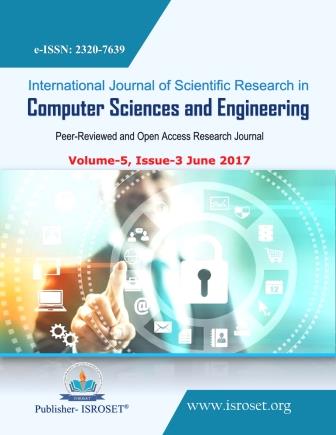A Novel Contact Based Mechanism to Decrease Overhead Ratio in Delay Tolerant Networks
Keywords:
DTN (Delay Tolerant Network), intermittent connectivity, Spray and Wait routing, Contact, ONE simulatorAbstract
DTN (Delay Tolerant Network) is wireless network in which data is transmitted through intermediate nodes. DTN provides store carry and forward mechanism to transfer messages from one node to another node. To transfer data between nodes, DTN provides some standard routing algorithms named epidemic routing, spray and wait routing, prophet and many more. Each routing mechanism has its own features as well as some drawbacks. In spray and wait routing, rate of replication of messages is too high while delivery ratio is also high. So, to overcome drawback of too high replication, the present research paper focuses on mechanism to measure contacts between nodes to reduce replication of messages .The contact is calculated between two nodes when they are in range of each other. In proposed algorithm, popularity vector is calculated based on duration of contacts between nodes. The value of the popularity vector of nodes will be used for selecting most appropriate node for message forwarding. High popularity value of a node will have more probability of successfully delivering the message. Proposed mechanism will reduce replication of messages and hence delivery ratio will be increased and overhead ratio will also decrease significantly.
References
S. Kapadia, B. Krishnamachari, L. Zhang, “Data Delivery in Delay Tolerant Networks: A Survey”, Mobile Ad Hoc Networks: Protocol Design, Intech, pp. 565-578, 2013.
S. Jain, K. Fall, R. Patra., “Routing in a Delay Tolerant Network”, In the Proceedings of ACM SIGCOMM, Indian pp. 145149, 2008.
A. Rani , A. Sharma, D. Singh, S. Indora, “Movement Models based Performance Comparison of Routing Protocols in DTN”, In the Proceedings of Second International Conference on ERCICA-14, India, pp.45-51, 2014.
D. Singh, S. Indora, A. Rani, A. Sharma ”Routing Policies & Strategies in Delay Tolerant Network”, National Conference on Advances in Engineering and Technology, India, pp.87-84, 2014.
T. Le, H. Kalantarian, M. Gerla, “A Buffer Management Strategy Based on Power-Law Distributed Contacts in Delay Tolerant Networks”, 2016 25th International Conference on Computer Communication and Networks (ICCCN), Waikoloa , pp.1-8, 2016.
Z. H. Kurniawan, L. V. Yovita, T. A. Wibowo, “Performance Analysis of Dlife Routing in a Delay Tolerant Networks”, International Conference on Control, Electronics, Renewable Energy and CommunicationsIEEE, Indonesia, pp.41-46, 2016.
S. Agrawal, K.D. Kulat, M. B.Daigavane, "Evaluation of Routing Algorithm for Ad-hoc and Wireless Sensor Network Protocol", International Journal of Computer Sciences and Engineering, Vol.1, Issue.2, pp.11-18, 2013.
B. Swetha, D.B. Rao, P.N. Rao, "Intelligent Anti-Theft Finding Scheme Towards Itrust Establishment in Delay Tolerant Networks Using VANET", International Journal of Computer Sciences and Engineering, Vol.2, Issue.9, pp.50-56, 2014.
H. Arai, M. Arai, “Erasure-Code-Based DTN Multi-Path Routing for Contact Avoidance”, IEEE 22nd Pacific Rim International Symposium on Dependable Computing, New Zealand, pp. 215-216, 2017.
S. Bhattacharjee, S. Basu, S. Roy, S. D. Bit, “Best-effort Delivery of Emergency Messages in Postdisaster Scenario with Content-based Filtering and Priority-enhanced PRoPHET over DTN”, 8th International Conference on Communication Systems and Networks, India,, pp. 1-7, 2016.
S. Burleigh, C. Caini, J. J. Messina, M. Rodolfi, “Toward a Unified Routing Framework for Delay-Tolerant Networking”, IEEE International Conference on Wireless for Space and Extreme Environments, India, pp: 82- 86, 2016.
S.Dinesh Kumar, G.Sathish Kumar, "Delay Tolerant Network (DTN): A Substitute Result for Efficient Trust Establishment", International Journal of Computer Sciences and Engineering, Vol.4, Issue.4, pp.252-257, 2016.
N. Das, A. Roy, S. D. Bit, “LionBEAR: A Location Based Energy Aware Routing Scheme in DTNs” IEEE Confernece, Russia ,pp. 75-80, 2014.
A. Sharma, “Opportunistic network environment: A multipurpose simulation tool for wireless networks”, Journal of Open Source Developments, Vol.2, Issue.4, pp. 1-5, 2015.
Downloads
Published
How to Cite
Issue
Section
License

This work is licensed under a Creative Commons Attribution 4.0 International License.
Authors contributing to this journal agree to publish their articles under the Creative Commons Attribution 4.0 International License, allowing third parties to share their work (copy, distribute, transmit) and to adapt it, under the condition that the authors are given credit and that in the event of reuse or distribution, the terms of this license are made clear.







